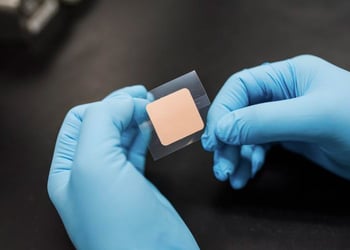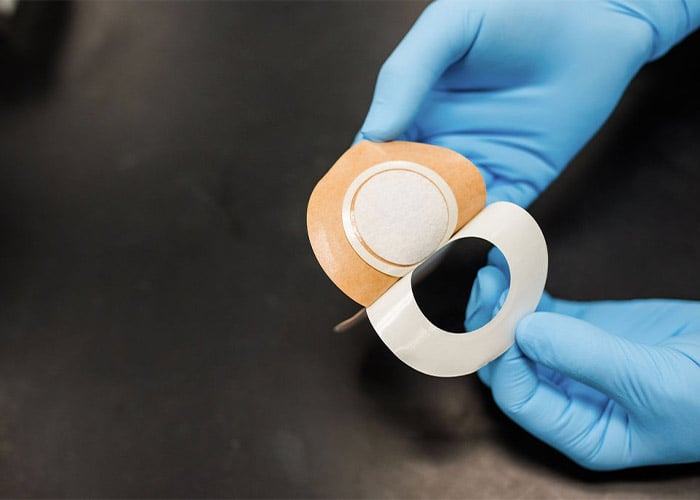Pills have come a long way since they were first made, which was probably around 1500 BC. While most patients prefer pills to injections, pills have a few problems of their own. First and foremost, pills must pass through the digestive system, where they often lose some of their active ingredients or cause unpleasant side effects. Additionally, pills containing controlled substances are often associated with abuse.
For these reasons, as well as many others, transdermal patch delivery represents an ideal solution for a multitude of therapies.
COMMON TRANSDERMAL PATCH DRUGS
As transdermal patch therapy is still relatively new, the list of drugs that are commonly delivered via patch is expected to grow significantly. At present, however, the most common types of transdermal patch therapies include the following:

- Nicotine
- Fentanyl and Buprenorphine
- Nitroglycerine
- Selegiline
- Methylphenidate
- Scopolamine
- Hormones
- Clonidine
- Rivastigmine
- Supplements
Let’s explore why patch delivery is critical for each of these treatments in the paragraphs below.
NICOTINE
While the first patch was approved by the FDA to treat motion sickness, it wasn’t until nicotine patches entered the market in the early ‘90s that the public became more aware of transdermal delivery. Transdermal patches are able to deliver a steady, consistent dose over a longer period of time in order to keep withdrawal symptoms at bay. Additionally, over the entire course of treatment, users can step down their dosage gradually using patches of different strengths.
FENTANYL AND BUPRENORPHINE
Fentanyl and Buprenorphine are both opiates and are used primarily to treat severe pain and opiate addiction, respectively. Human beings have used opium to alleviate suffering since the beginning of recorded history. However, what was once hailed as a gift of the gods has also caused quite a bit of suffering due to the ease at which this treatment can be abused.
While it’s not impossible, transdermal treatments are much harder to misuse. Additionally, just like with nicotine patches, transdermal delivery allows for a slower, steadier dose, with fewer side effects.
NITROGLYCERINE
Nitroglycerine is used to prevent chest pain or pressure associated with angina. While there are nitroglycerine ointments available, they’re greasy and messy. Transdermal delivery, on the other hand, is precise, steady, and much more convenient.
SELEGILINE
One of the most effective anti-depressants, studies suggest that selegiline patches also offer relief quicker than other treatment options, as early as the first week. Additionally, many oral anti-depressants are associated with gastrointestinal upset and a heightened risk of suicide, whereas in clinical trials, patch therapy demonstrated better efficacy in a wider range of patients, with less risk of side effects and suicidal tendencies.
METHYLPHENIDATE
Methylphenidate can be delivered transdermally as a treatment for ADHD. It is intended for use in children between the ages of six and 17. While oral stimulants are frequently associated with addiction issues, especially among teens, transdermal patch delivery is much less likely to be abused.
SCOPOLAMINE
Scopolamine is frequently used to counter motion sickness or to ease nausea after surgery. Transdermal therapy allows the medication to be more effective at a lower dose, with a slower, steady delivery of up to three days.
HORMONES
The liver is very effective at removing hormones passing through the digestive system. Pills containing testosterone or estrogen overcome this barrier by delivering ten to 20 times the active ingredient required. Transdermal patches are able to deliver a much lower dose more effectively.
CLONIDINE
Clonidine is used to treat high blood pressure. Patch delivery is just as effective as oral medication. However, according to one study, more patients prefer a weekly patch, which could lead to improved compliance.
RIVASTIGMINE
Rivastigmine is frequently used to treat dementia, including dementia related to Alzheimer’s disease or Parkinson’s. In oral medications, the side effects may include nausea and vomiting, decreased appetite, and weight loss.
As transdermal patches do not have to be swallowed or chewed, they’re often an easier form of treatment for patients with Central Nervous System (CNS) conditions like Parkinson’s. It’s also easier to track compliance with a visible daily patch. However, one of the biggest advantages of a Rivastigmine patch is that in circumventing the digestive system, patients experience fewer and less severe side effects.
SUPPLEMENTS
While vitamins and other dietary supplements are frequently available in pills, liquids, or powders, they’re often difficult to swallow, hard on the digestive system, and accompanied by an unpleasant taste. Furthermore, as oral supplements often contain fillers, dyes, sweeteners, and preservatives, transdermal patches are an increasingly popular alternative for fitness and health enthusiasts.
FUTURE USES FOR TRANSDERMAL PATCHES
The technology exists today to deliver many drugs via transdermal patch. But one significant barrier to developing more transdermal treatments is that drugs must be absorbed through the skin. Large molecule drugs, for example, are not readily absorbed through the skin. However, Tapemark is currently developing new technology to enable more drugs to be delivered transdermally.
%20-%20Copy.jpg?width=700&name=BlogImages_TransdermalPatch_1%20(1)%20-%20Copy.jpg)
Today, large molecule drugs like insulin are typically delivered via injection. In the future, Microneedle patches like Tapemark’s revolutionary MicroDerm™ will allow insulin delivery without the pain and inconvenience of hypodermic needles. MicroDerm also has tremendous potential to deliver vaccines around the world, which is especially helpful in areas where the re-use of needles is commonplace. Furthermore, Tapemark’s MacroPermTM is designed to transport Active Pharmaceutical Ingredients (API), up to 25,000 dalton — an achievement that was previously thought to be impossible.
In addition to insulin and various vaccines, drugs like Fosamax (an osteoporosis treatment) that are known to cause unpleasant side effects may be good candidates for eventual transdermal delivery. The beauty industry is also eyeing transdermal therapies for future use.
WHAT DRUGS AREN’T SUITABLE FOR TRANSDERMAL PATCHES?
In order for a drug to be delivered transdermally, it needs to be able to pass through the skin to enter the bloodstream, and it must be effective in a relatively low dose. At present, there are only a small number of drugs that are suitable for transdermal delivery. However, that number is expanding rapidly.
WHEN IS PATCH THERAPY IDEAL?
Drug developers considering creating a transdermal patch would do well to prioritize medications that fall into one or more of the following categories:
- Medications that cause unpleasant side effects, especially to the gastrointestinal system
- Medications intended primarily to treat patients with CNS conditions
- Medications that are frequently abused
- Vaccines or other therapies that require hypodermic needles
- Medications containing active ingredients that the liver removes
- Medications that adversely affect the liver
- Long-term treatment regimens where patient compliance is low
WHEN IS ANOTHER DRUG DELIVERY OPTION BETTER?
Transdermal patches are often preferred by patients who want to avoid unpleasant side effects or have targeted therapy on the go. But transdermal patches do have some disadvantages of their own. For example, some patches can irritate the skin, depending on the adhesive and the active ingredients contained, causing itching, redness, or blistering.
Despite the incredible number of advantages transdermal patches can offer end-users, some drugs are best delivered by another means. If all of the following are true, a pill may, in fact, be the better delivery method:
- The ingredients don’t cause unpleasant side effects
- The liver isn’t adversely affected
- It doesn’t require hypodermic needles, and is easy to swallow without water
- Treatment isn’t time-sensitive
- It isn’t easily abused
- It isn’t readily absorbed through the skin using available technology
HOW TO DEVELOP AN EFFECTIVE TRANSDERMAL PATCH

Pioneering a new transdermal patch is a significant undertaking. As a full-service Contract Development and Manufacturing Company (CDMO), Tapemark partners with clients around the world to develop new transdermal patches, oral thin films, and unit dose semi-solid therapies.
Tapemark can take on some or all aspects of drug development and manufacturing, and can reduce friction throughout the process. With an audit success rate of 100% and over 82 successful commercial product launches in the last 20 years, we have the industry-leading expertise to develop the most complex transdermal patch therapies in the market.
